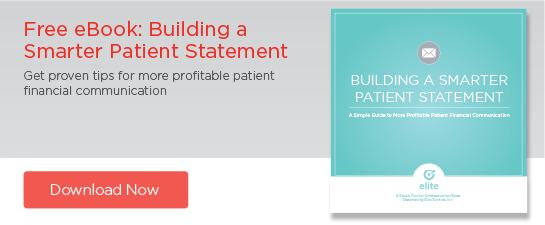Using Smart Segmentation to Improve Patient Statement Effectiveness
December 22, 2014 •Brian Watson

 If you’re a healthcare revenue cycle professional that’s not leveraging personalization in your patient financial communication, then you’re leaving money on the table – plain and simple.
If you’re a healthcare revenue cycle professional that’s not leveraging personalization in your patient financial communication, then you’re leaving money on the table – plain and simple.
A one-size-fits-all approach to billing operations will simply not provide the granular focus you need to collect self-pay revenue from patients with diverse financial profiles, payment histories, and insurance coverage. Personalization of billing activities not only improves statement effectiveness, it can help providers better allocate strained business office staff and resources.
Additionally, patients are also on board, rating personalized content as the second most-important change providers can make to improve their billing statements.
But the kind of personalization that moves the needle on cash collections and business office costs usually requires meaningful data
This is a secret that direct marketers have long understood – and used to great effect.
Every time a consumer makes a purchase they’re sharing intimate details about their lives with retailers. Over time, clear patterns emerge that can be used by marketers to make inferences about consumers; inferences that are then used to personalize the offers they receive.
Occasionally purchase behavior-based algorithms can get so personalized and predictive it borders on creepy. Outliers aside, personalization is largely win-win for both marketers and consumers. Businesses increase ROI by providing targeted, relevant messaging. And consumers receive offers for products that they might actually use.
In a similar sense, providers have access to a wealth of patient financial, payment history, demographic and treatment data that can be used to help personalize revenue cycle operations and enhance profitability.
The key is predictive segmentation – categorizing patients for follow-up financial activities based upon their propensity to pay an outstanding balance.
Predictive segmentation of self-pay patients enables providers to be proactive rather than reactive in how they pursue outstanding revenue, with a goal of using scarce revenue cycle resources most efficiently.
Segmenting for ROI
The reality is that many self-pay patients are a bad investment from an ROI standpoint. Most self-pay revenue comes from a very small number of accounts – usually between 20% and 30% on average. And 81% of self-pay net receivables go unrecovered.
Facing a higher portion of self-pay revenue – patients now trail only Medicare and Medicaid as a source of revenue for providers – but limited by mounting financial pressures, business offices are in the unenviable position of having to do more with less. That scenario underscores the importance of predicative revenue analytics.
Investing resources to print and mail statements to all patients with an outstanding self-pay balance – regardless of financial means or propensity-to-pay – is a recipe for sub-par returns.
That population likely includes frequent flyers, patients that could qualify for charity care or financial assistance, and patients that are otherwise unlikely to pay without some type of financial outreach – either personal attention from business office employees or the threat of collection proceedings. In fact the Healthcare Financial Management Association estimates that of all balance that become bad debt, up to 25% should actually be classified as charity care.
The point is there’s a wide degree of variance among patients that carry a self-pay balance. And painting all those accounts with the same brush is inefficient both in terms of resources used and the effectiveness of patient engagement tactics
Predictive analytics and self-pay segmentation enables providers to truly personalize the patient billing experience. Not just customizing the messaging of patient statements and letters, but also the number of statements sent, the timing of delivery, and the desired financial outcome.
For example, a self-pay patient that meets internal charity care predictive metrics might be opted out of statement delivery entirely or presumptively delivered a charity care application. While a patient that scores highly on propensity-to-pay would be placed into a traditional statement delivery queue.
Approaching different patient populations with a strategy that delivers the most revenue, at the lowest overhead enhances profitability, reduces billing overhead, and helps providers deliver a billing experience that meets customer expectations.
Smarter Self-Pay Account Segmentation
One of the most common ways that providers segment self-pay patients for targeted follow-up is by balance size.
Devoting more attention to large accounts makes sense intuitively: collecting even a portion of a balance over $1000 can provide the same revenue as dozens of accounts with balances of less than $25.
But the reality is that a high balance-due doesn’t correlate with a higher propensity-to-pay. Providers are just as likely to find patients without the means to pay in a high-dollar population as they are in other self-pay segments – perhaps even more so due to lack of insurance coverage.
The need to do more with less has many providers instead opting for data-driven segmentation models that prioritize payment probability over balance size.
Propensity-to-Pay Scoring
Propensity-to-pay models typically blend external and proprietary data to provide a robust, predictive algorithm.
External data often includes credit score and demographic information, while key internal intelligence is comprised of individual patient payment history and historic encounter-based payment performance.
For example, a provider might discover that patients receiving knee replacement surgery are more likely to pay than a control population because of the need for additional physical therapy encounters post-surgery.
Financial Assistance Screening
Patient assistance screening models evaluate demographic, financial profile, and publicly available information – such as enrollment in safety-net food and housing programs – to presumptively identify patients that might qualify for Medicaid, charity care discounts, or federal HIX subsidies of tax credits.
Putting the Pieces Together: Using Segmentation to Improve Patient Billing Operations
Presumptive Enrollment in Financial Assistance
Many providers are leveraging the predictive financial aid tools described above to identify – and presumptively enroll – patients for charity care outreach that may not have applied for assistance during an encounter.
This work-around enables hospitals to move accounts from a general patient accounts workflow to one that’s specifically focused on financial assistance outreach. That could mean, for example, suppressing statement delivery and instead following-up directly by phone.
Specialized Billing Follow-up
Predictive segmentation is used to improve profitability and return-on-investment by providing more effective utilization of collection resources.
Patients are typically grouped into separate buckets that determine billing activities based upon propensity-to-pay data.
For example, patients that have a high propensity-to-pay score that can be expected to pay promptly within a traditional statement processing cycle would be one category, while additional buckets would focus on patients that have lower ratings on payment probability metrics.
In this model, financial tools used, desired billing outcomes, statement messaging and timing, and engagement frequency are all customized based upon the patient’s unique financial and payment history. The result is a truly personalized billing experience that benefits both patient and provider alike.
Get Updates
Featured Articles
Categories
- Charity Care Management (1)
- Compliance (2)
- Customer Service (8)
- Digital Front Door (1)
- Direct Mail (6)
- eBilling (1)
- EBPP (34)
- ESL Statement (2)
- eStatement (1)
- Healthcare Channel Partner Billing (1)
- IVR (3)
- Mobile Payment (11)
- Online Billing and Payment (6)
- Online Patient Payment (17)
- Outsource Print Management (4)
- Paperless Billing (4)
- Patient Engagement (2)
- Patient Friendly Billing (21)
- Print and Mail (7)
- QR Codes (1)
- Quick Pay (7)
- Security (1)
- Self-Pay Patients (9)
- Self-Pay Revenue (4)
- Statement Design (32)
- Statement Print and Mail (1)
- Statement Printing and Mailing (28)
- Statement Processing (36)
- TransPromo (1)
- Up-Front Billing (1)


